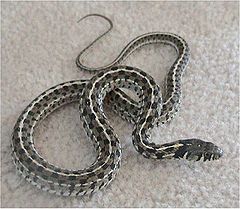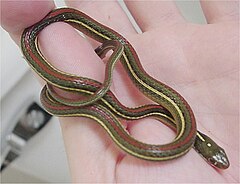Garter snake: Difference between revisions
m robot Adding: de, fr, lt, uk |
Added article to Category:Snakes |
||
| Line 159: | Line 159: | ||
[[Category:Fauna of Mexico]] |
[[Category:Fauna of Mexico]] |
||
[[Category:Reptiles of Central America]] |
[[Category:Reptiles of Central America]] |
||
[[Category:Snakes]] |
|||
[[de:Strumpfbandnattern]] |
[[de:Strumpfbandnattern]] |
||
[[fr:Thamnophis]] |
[[fr:Thamnophis]] |
||
Revision as of 18:19, 12 June 2007
| Garter snakes | |
|---|---|

| |
| Red-sided Garter Snake Thamnophis sirtalis parietalis | |
| Scientific classification | |
| Kingdom: | |
| Phylum: | |
| Class: | |
| Order: | |
| Suborder: | |
| Family: | |
| Genus: | Thamnophis |
| Species | |
|
Many; see article. | |
A garter snake is any species of North American snake within the genus Thamnophis. Because of the similarity in sound of the words, combined with where people often see it, they are sometimes called garden snakes.
Garter snakes are extremely common all across North America, Canada and to Central America. They are the single most widely distributed species of reptile in North America, and is a common sight in American gardens, giving rise to its "garden snake" nickname. In fact, the common garter snake, T. sirtalis, is the only species of snake to be found in Alaska, and is one of the northernmost species of snake in the world, possibly second only to the Crossed Viper, Vipera berus. The genus is so far ranging due to its unparticular diet and adaptability to different biomes and landforms, from marshes to hillsides to drainage ditches and even vacant lots, in both dry and wet regions, with varying proximity to water and rivers. However, in the western part of North America, these snakes are more water-loving than in the eastern portion. Northern populations hibernate in larger groups than southern ones. Despite the decline in their population from collection as pets (especially in the more northerly regions in which large groups are collected at hibernation), pollution of aquatic areas, and introduction of bullfrogs and bass as predators, this is still a very commonly found snake. The San Francisco garter snake, Thamnophis sirtalis tetrataenia, however, is an endangered subspecies and has been on the endangered list since 1967. Predation by crayfish has also been responsible for the decline of the narrowhead garter snake, T. rufipunctatus.
There is no real consensus exactly how many species of Thamnophis there are, and disagreement among taxonomists and sources, such as field guides, over whether two types of snakes are separate species or subspecies of the same species is common. They are also closely related to the snakes of the genus Nerodia, and some species have been moved back and forth between genera.
Description
There is little variation within the pattern of scales among the different varieties of garter snakes, but coloration varies widely across varieties and geographic regions.
The pattern on these snakes consists of one or three longitudinal stripes on the back, typically red, yellow or white. The snake genus got its common name because people described the stripes as resembling a garter. In between the stripes on the pattern are rows with blotchy spots. Even within a single species the color in the stripes and spots and background can differ. In some species the stripes vary little in color from the adjacent bands or background and are not readily seen. Most garter snakes are under 60 cm (24 inches) long, but can be larger. T. gigas is capable of attaining lengths of 160cm.
Diet
Garter snakes, like all snakes, are carnivorous. Their diet consists of almost any creature that they are capable of overpowering: slugs, earthworms, insects, leeches, lizards, amphibians, birds, fish, and rodents. When living near the water, they will eat other aquatic animals. The ribbon snake in particular favors frogs (including tadpoles), readily eating them despite their strong chemical defenses.[citation needed] Food is swallowed whole. Although they dine mostly upon live animals, they will sometimes eat eggs].
Behavior
Garter snakes of all species are gregarious (when not in brumation or aestivation). They have complex systems of pheromonal communication. They can locate other snakes by following their pheromone-scented trails. Male and female skin pheromones are so different as to be immediately distinguishable. However, sometimes male garter snakes produce both male and female pheromones. During mating season, this fact fools other males into attempting to mate with these "pseudo-females". It is often these males, with the female pheromone genetic variation, that are among the first to mate. By expressing the male pheromone, they still attract females. But, the expression of the female pheromone leads to fruitless mating attempts by other males.
Pet garter snakes, while never becoming "tame" in the strictest sense of the word, learn to associate their keepers with food and other postive experiences. When handled or brought out of their tank, they quickly calm down and become curious about their surroundings.
If disturbed, a garter snake may strike, and will often coil, but typically it will hide its head and flail its tail about. These snakes will also discharge a malodorous, musky-scented secretion from the anal gland. They often use these techniques to escape when ensnared by a predator. They will also slither into the water to escape a predator on land. Hawks, crows, raccoons, crayfish and other snake species (such as the coral snake and king snake) will eat garter snakes, with even shrews and frogs eating the juveniles.
Being heterothermic, like all reptiles, garter snakes bask in the sun to keep their body temperature warm (at 28 to 32 degrees Celsius) during the morning. The temperature is lower during the evening. Garter snakes will often sleep together to maintain a warm body temperature at night. During hibernation, they will sleep in large, communal nests called hibernacula. These snakes will migrate large distances to brumate.
Reproduction
Garter snakes go into brumation before they mate. Before they can do this, they stop eating for about two weeks to clear their stomach of any food that would rot there otherwise. Garter snakes begin mating as soon as they emerge from brumation. During mating season, the males will mate with several females. In chillier parts of their range, male common garter snakes will awaken from brumation first, giving themselves enough time to prepare to mate with females when they finally appear. Males come out of their dens and, as soon as the females begin coming out, will surround them. A male sends out pheromones, and the female will follow the pheromones to an attractive male and mate with him. Once impregnated, a female will retire from the mating ring and find food and a place to give birth. Female garter snakes are able to store the male's sperm before beginning the accouchement. The young are incubated in the lower abdomen, at about the midpoint of the length of the mother's body. Garter snakes are ovoviviparous. Gestation is two to three months. As few as 3 or as many as 50 may be born in a single litter. The babies are independent upon birth, abandoning the mother.
Taxonomy
- Longnose Garter Snake, Thamnophis angustirostris (Kennicott, 1860)
- Aquatic Garter Snake, Thamnophis atratus
- Santa Cruz Garter Snake, Thamnophis atratus atratus (Kennicott, 1860)
- Oregon Garter Snake, Thamnophis atratus hydrophilus (Fitch, 1936)
- Diablo Range Garter Snake, Thamnophis atratus zaxanthus (Boundy, 1999)
- Shorthead Garter Snake, Thamnophis brachystoma (Cope, 1892)
- Butler's Garter Snake, Thamnophis butleri (Cope, 1889)
- Goldenhead Garter Snake, Thamnophis chrysocephalus (Cope, 1885)
- Western Aquatic Garter Snake, Thamnophis couchii (Kennicott, 1859)

- Blackneck Garter Snake, Thamnophis cyrtopsis
- Western Blackneck Garter Snake, Thamnophis cyrtopsis cyrtopsis (Kennicott, 1860)
- Eastern Blackneck Garter Snake, Thamnophis cyrtopsis ocellatus (Cope, 1880)
- Tropical Blackneck Garter Snake, Thamnophis cyrtopsis collaris (Jan, 1863)
- Tepalcatepec Valley Garter Snake, Thamnophis cyrtopsis postremus (Smith, 1942)
- Yellow-throated Garter Snake, Thamnophis cyrtopsis pulchrilatus (Cope, 1885)
- Western Terrestrial Garter Snake, Thamnophis elegans
- Arizona Garter Snake, Thamnophis elegans arizonae (Tanner & Lowe, 1989)
- Mountain Garter Snake, Thamnophis elegans elegans (Baird & Girard, 1853)
- Mexican Wandering Garter Snake, Thamnophis elegans errans (Smith, 1942)
- Coast Garter Snake, Thamnophis elegans terrestris (Fox, 1951)
- Wandering Garter Snake, Thamnophis elegans vagrans (Baird & Girard, 1853)
- Upper Basin Garter Snake, Thamnophis elegans vascotanneri (Tanner & Lowe, 1989)
- Sierra San Pedro Mártir Garter Snake, Thamnophis elegans hueyi (Van Denburgh & Slevin, 1923)
- Thamnophis eques
- Mexican Garter Snake, Thamnophis eques eques (Reuss, 1834)
- Laguna Totolcingo Garter Snake, Thamnophis eques carmenensis (Conant, 2003)
- Thamnophis eques cuitzeoensis (Conant, 2003)
- Thamnophis eques diluvialis (Conant, 2003)
- Thamnophis eques insperatus (Conant, 2003)
- Northern Mexican Garter Snake, Thamnophis eques megalops (Kennicott, 1860)
- Thamnophis eques obscurus (Conant, 2003)
- Thamnophis eques patzcuaroensis (Conant, 2003)
- Thamnophis eques scotti (Conant, 2003)
- Thamnophis eques virgatenuis (Conant, 1963)

- Montane Garter Snake, Thamnophis exsul (Rossman, 1969)
- Highland Garter Snake, Thamnophis fulvus (Bocourt, 1893)
- Giant Garter Snake, Thamnophis gigas (Fitch, 1940)
- Godman's Garter Snake, Thamnophis godmani (Günther, 1894)
- Two-striped Garter Snake, Thamnophis hammondii (Kennicott, 1860)
- Checkered Garter Snake, Thamnophis marcianus (Baird & Girard, 1853)
- Blackbelly Garter Snake, Thamnophis melanogaster
- Gray Blackbelly Garter Snake, Thamnophis melanogaster canescens (Smith, 1942)
- Chihuahuan Blackbelly Garter Snake, Thamnophis melanogaster chihuahuanensis (Tanner, 1959)
- Lined Blackbelly Garter Snake, Thamnophis melanogaster linearis (Smith, Nixon & Smith, 1950)
- Mexican Blackbelly Garter Snake, Thamnophis melanogaster melanogaster (Peters, 1864)
- Tamaulipan Montane Garter Snake, Thamnophis mendax (Walker, 1955)
- Northwestern Garter Snake, Thamnophis ordinoides (Baird & Girard, 1852)
- Western Ribbon Snake, Thamnophis proximus
- Chiapas Highland Ribbon Snake, Thamnophis proximus alpinus (Rossman, 1963)
- Arid Land Ribbon Snake, Thamnophis proximus diabolicus (Rossman, 1963)
- Gulf Coast Ribbon Snake, Thamnophis proximus orarius (Rossman, 1963)
- Western Ribbon Snake, Thamnophis proximus proximus (Say, 1823)
- Redstripe Ribbon Snake, Thamnophis proximus rubrilineatus (Rossman, 1963)
- Mexican Ribbon Snake, Thamnophis proximus rutiloris (Cope, 1885)

- Plains Garter Snake, Thamnophis radix (Baird & Girard, 1853)
- Rossman's Garter Snake, Thamnophis rossmani (Conant, 2000)
- Narrowhead Garter Snake, Thamnophis rufipunctatus
- Eastern Ribbon Snake, Thamnophis sauritus
- Bluestripe Ribbon Snake, Thamnophis sauritus nitae (Rossman, 1963)
- Peninsula Ribbon Snake, Thamnophis sauritus sackenii (Kennicott, 1859)
- Eastern Ribbon Snake, Thamnophis sauritus sauritus (Linnaeus, 1766)
- Northern Ribbon Snake, Thamnophis sauritus septentrionalis (Rossman, 1963)
- Longtail Alpine Garter Snake, Thamnophis scalaris (Cope, 1861)
- Short-tail Alpine Garter Snake, Thamnophis scaliger (Jan, 1863)
- Common Garter Snake, Thamnophis sirtalis
- Texas Garter Snake, Thamnophis sirtalis annectens (Brown, 1950)

Texas Garter Snake, Thamnophis sirtalis annectens - Red-spotted Garter Snake, Thamnophis sirtalis concinnus (Hallowell, 1852)
- New Mexico Garter Snake, Thamnophis sirtalis dorsalis (Baird & Girard, 1853)
- Valley Garter Snake, Thamnophis sirtalis fitchi (Fox, 1951)
- California Red-sided Garter Snake, Thamnophis sirtalis infernalis (Blainville, 1835)
- Thamnophis sirtalis lowei (Tanner, 1988)
- Maritime Garter Snake, Thamnophis sirtalis pallidulus (Allen, 1899)
- Red-sided Garter Snake, Thamnophis sirtalis parietalis (Say, 1823)
- Puget Sound Garter Snake, Thamnophis sirtalis pickeringii (Baird & Girard, 1853)
- Bluestripe Garter Snake, Thamnophis sirtalis similis (Rossman, 1965)
- Eastern Garter Snake, Thamnophis sirtalis sirtalis (Linnaeus, 1758)
- Chicago Garter Snake, Thamnophis sirtalis semifasciatus (Cope, 1892)
- San Francisco Garter Snake, Thamnophis sirtalis tetrataenia (Cope, 1875)
- Texas Garter Snake, Thamnophis sirtalis annectens (Brown, 1950)
- Sumichrast's Garter Snake, Thamnophis sumichrasti (Cope, 1866)
- West Coast Garter Snake, Thamnophis valida
- Mexican Pacific Lowlands Garter Snake, Thamnophis valida celaeno (Cope, 1860)
- Thamnophis valida isabellae (Conant, 1953)
- Thamnophis valida thamnophisoides (Conant, 1961)
- Thamnophis valida valida (Kennicott, 1860)

